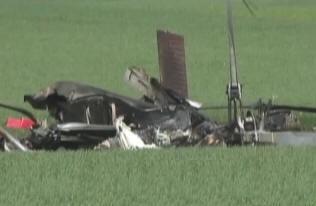 |
|
|
|
|
|
|||
|
Hospital Wing Helicopter Crashes Killing All Onboard |
||||
 |
March 26, 2010 -
On Thursday at about 6 AM, a Hospital Wing helicopter with a three man
crew crashed about 5 miles east of All three emergency medical services (EMS) crew members onboard the single engine Eurocopter AS350 helicopter were killed, there were no patients onboard at the time of the crash. It was reported that the weather at the time of the crash included thunderstorms, lightning and heavy rain showers. |
|||
|
The single
pilot has been identified as 58 years old Doug Phillips. There were
two flight nurses onboard, Cindy Parker, 48 years old and Misty
Brogdon, 36 years old.
Hospital wing "The Wing" is a non-profit air medical transport, that provides inter-hospital transfers as well as emergency scene calls within 150 mile radius of Memphis that includes West Tennessee, Arkansas, Mississippi, Missouri, Alabama, and Kentucky. The company was founded in 1985. The company owns and operates 5 helicopters that are equipped to transport critically ill and injured patients. Hospital wing has three helicopters that are staffed 24 hours a day, seven days a week and one helicopter is available for PediFlite. Hospital Wing transports an average of 150 patients per month with 60% of these being trauma related and scene flights account for approximately 35% of there operations.
|
||||
|
Although the NTSB
issued recommendations in 2006 to improve
?
December 3, 2007:
?
December 30, 2007: Cherokee,
?
February 5, 2008: South
?
May 10, 2008:
?
June 8, 2008:
?
June 29, 2008:
?
August 31, 2008:
?
September 27, 2008:
?
October 15, 2008:
?
September 25, 2009:
?
November 14, 2009:
The NTSB is
concerned that these types of accidents will continue to occur if a
concerted effort is not made to improve the safety of emergency medical
flights. Specifically, the following actions would help to improve the
safety of EMS flight operations:
(1) conduct of all flights with medical personnel on board in
accordance with stricter commuter aircraft regulations,
(2) implementation of a flight risk evaluation program for EMS
operators, (3) establishment of formalized dispatch and flight-following
procedures including up-to-date weather regulations, and (4)
installation of terrain awareness and warning systems on aircraft used
for EMS operations.
In August 2004,
the Federal Aviation Administration (FAA) convened a Helicopter Air
Ambulance Accident Task Force to make recommendations to reduce HEMS
accidents; however, in spite of numerous actions to address this issue
through notices and guidance, little progress has been made by the FAA
to improve the safety of
In 2005, the FAA
issued the following three notices addressing HEMS safety; however, all
three of the following notices expired after 1 year:
In June 2006, at
the FAA?s request, RTCA, Inc. (formerly the Radio Technical Commission
for Aeronautics), established a special committee to develop Helicopter
TAWS (HTAWS) standards; minimum performance standards were completed in
2008, and in December 2008, the FAA issued Technical Standards Order
(TSO) C-194 to standardize the manufacture of HTAWS within the industry.
In January 2009,
FAA principal operations inspectors conducted a survey of the 74 HEMS
operators to determine how many planned to equip their fleets with
TSO-approved HTAWS. That
survey revealed that 41 percent were planning to equip their fleets with
HTAWS.
In May 2008, the
FAA incorporated the contents of Notice N8000.301 into Order 8900.1,
encouraging the use of risk assessment models.
In addition, the FAA published Advisory Circular (AC) 120-96
regarding operations control centers (OCC) for HEMS, providing a list of
tasks that should be completed by OCCs; however, Safety Recommendation
A-06-14 asks the FAA to incorporate a requirement for an OCC into HEMS
regulations. The January
12, 2009, survey of all 74 HEMS operators previously included how many
had adopted the best practices specified in AC 120-96.
It was determined that 94 percent had adopted decision-making
skills and risk assessment programs, and 89 percent had integrated an
OCC.
In November 2008,
the FAA published revised Operation Specification (OpSpec) A021, to
specify that, if a flight, or sequence of flights, includes a Part 135
segment, then all visual flight rule (VFR) segments of the flight must
be conducted within the weather minimums and minimum safe cruise
altitude determined in pre-flight planning. Specifically, pilots must
identify a minimum safe cruise altitude during pre-flight planning by
identifying and documenting obstructions and terrain along the planned
flight path and must also determine the minimum required ceiling and
visibility to conduct the flight. As of February 2009, all HEMS
operators have complied with this OpSec.
The NTSB concluded
in its 2006 report that a requirement for all EMS operators to comply
with 14 CFR Part 135 OpSpecs during the conduct of all flights with
medical personnel on board, would enhance the safety of
In February 2009,
the NTSB held a 4-day public hearing to learn more about helicopter
In April 2009, the
FAA started a formal rulemaking project to address many of the HEMS
initiatives and best practices found in advisory circulars, orders, and
notices issued over the last several years, as well as the November 2008
revisions to HEMS operating specifications. In November 2009, the FAA
stated that its notice of proposed rulemaking (NPRM) will also address a
requirement for HEMS operators to equip their fleets with, and use,
HTAWS; however, it has been almost a year since the FAA started the
rulemaking project, and an NPRM has not yet been published.
The NTSB?s
recommendations concerning
Actions Remaining:
Require all
Require all EMS
operators to develop and implement flight risk evaluation programs that
include training all employees involved in the operation, procedures
that support the systematic evaluation of flight risks, and consultation
with others trained in
Require |
| ?AvStop
Online Magazine
Contact
Us
Return To News
|
|
